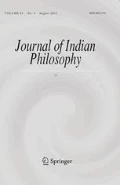Abstract
The purpose of this paper is to examine some of the key points of Nāgārjuna’s discussion of problems relating to the philosophy of language. We will focus on two works from Nāgārjuna’s yukti-corpus that address these matters most explicitly, the Vigrahavyāvartanī (VV) and the Vaidalyaprakaraṇa (VP). The discussion will concentrate on four topics: Nāgārjuna’s views on semantics, the problem of empty names, the relation between language and momentariness, and the implications of Madhyamaka views on parts and wholes for the existence of language.
Similar content being viewed by others
References
Gokhale, V. (1930). Akṣara-Çatakam. The Hundred Letters, A Madhyamaka Text by Āryadeva, After Chinese and Tibetan Materials. Heidelberg: Harrassowitz.
Jha, G. (1986). The Tattvasasaṃgraha of Shāntarakṣita: With the Commentary of Kamalashīla. Delhi: Motilal Banarsidass.
Li, X. (2015). Madhyamakāvatāra-kārikā Chapter 6. Journal of Indian Philosophy, 4,: 1–30.
Pind, O. H. (2001). Why the Vaidalyaprakaraṇa cannot be an authentic work of Nāgārjuna”. Wiener Zeitschrift für die Kunde Süd-und Ostasiens, 25, 149–172.
Śāstrī, S. D. (2006). The Tattvasaṅgraha of Ācārya Śāntarakṣita with the ‘Pañjikā’ Commentary of Ācārya Kamalaśīla. Varanasi: Bauddha Bharati.
Śāstrī, S. D. (1998). Mahāmuni Vātsyāyan’s Nyāya-Bhāṣya on Gautama-Nyāya-Sutras with Prasannapadā Commentary of Pt. Sudarśanācārya, Śāstrī. Varanasi: Bauddha Bharati.
VP: Nāgārjuna’s Vaidalyaprakaraṇa. See Tola and Dragonetti 1985.
VV: Nāgārjuna’s Vigrahavyāvartanī. See Yonezawa 2008.
Siderits, M. (2007). Buddhism as Philosophy: An Introduction. Hackett, Indianapolis, IN: Ashgate, Aldershot.
Tola, F., & Dragonetti, C. (1981). Nāgārjuna’s conception of ‘voidness’ (śūnyatā). Journal of Indian Philosophy, 9, 273–282.
Tola, F., & Dragonetti, C. (1982). Dignāga’s Ālambanaparīkṣāvṛtti. Journal of Indian Philosophy, 10, 105–134.
Tola, F., & Dragonetti, C. (1985). Nāgarjuna’s Refutation of Logic (Nyāya): Vaidalyaprakaraṇa. Delhi: Motilal Banarsidass.
Westerhoff, J. (2010). The Dispeller of Disputes: Nāgārjuna’s Vigrahavyāvartanī. Oxford: Oxford University Press.
Yonezawa, Y. (2008). Vigrahavyāvartanī: Sanskrit transliteration and Tibetan translation. Journal of the Naritasan Institute for Buddhist Studies, 31, 209–333.
Author information
Authors and Affiliations
Corresponding author
Rights and permissions
About this article
Cite this article
Westerhoff, J. Nāgārjuna and the Philosophy of Language. J Indian Philos 47, 779–793 (2019). https://doi.org/10.1007/s10781-017-9341-3
Published:
Issue Date:
DOI: https://doi.org/10.1007/s10781-017-9341-3




